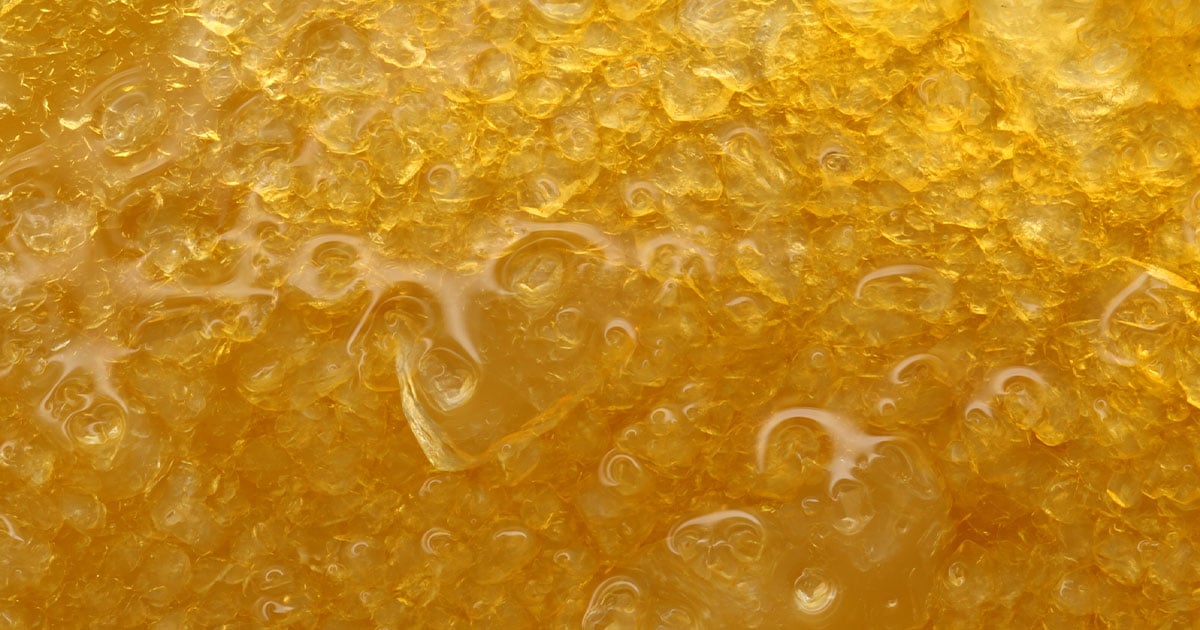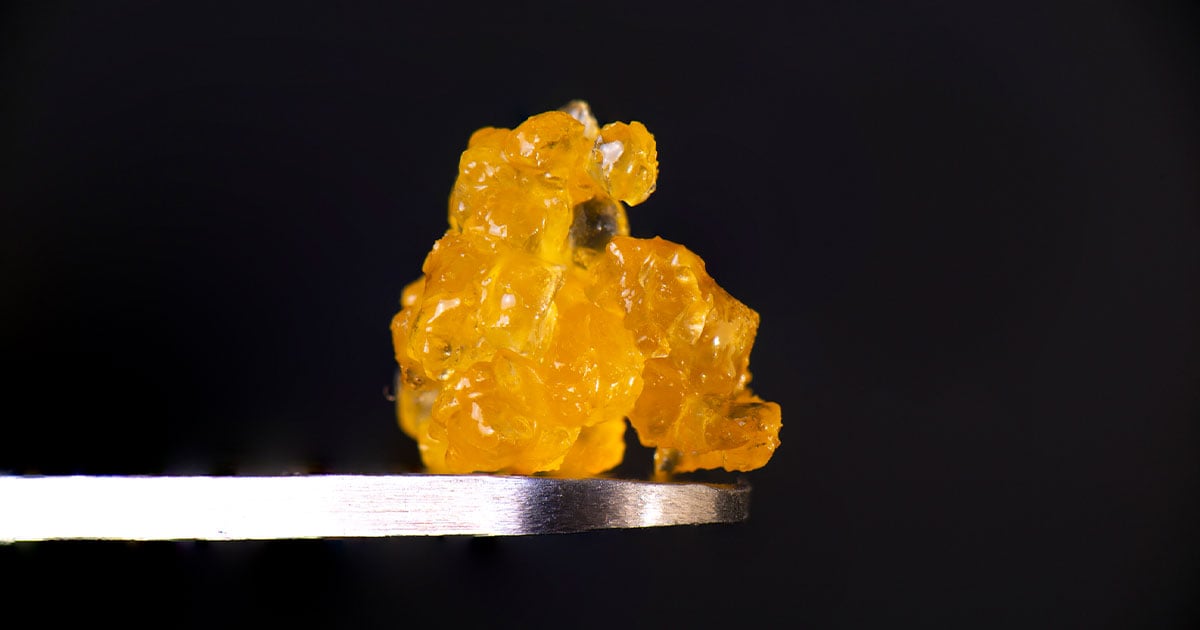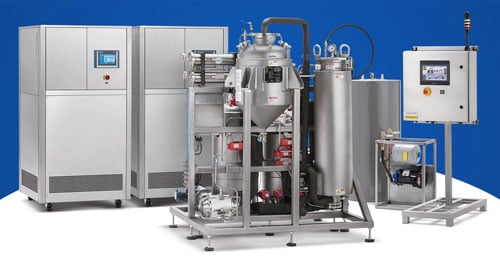
Cannabis concentrates have come a long way, quality-wise, over a relatively short period of time. Today, we have a wide range of extract types to choose from including two of the most flavorful and aromatic concentrates on the market: live rosin and live resin.
What Does It Mean When Resin and Rosin Are Live?
Traditionally, cannabis concentrates are made using dried and cured marijuana flowers and trim. However, this standard drying and curing process, which aims to reduce excess moisture, sugars, and chlorophyll in the cannabis plant, can result in a significant loss of the plant’s temperature-sensitive terpenes.
Once the flower buds have been harvested, the plant branches are hung up or laid on a screen to dry out for a couple of weeks. When they are sufficiently dried, the buds are pruned and placed in an airtight container and left to cure for at least a month or more for better flavors and aroma.
When concentrates are “live,” processors forgo the drying and curing process and, instead, immediately freeze their marijuana bud and trim material and use very low temperatures during the extraction process to eliminate the evaporation of terpenes with low boiling points. By using low temperatures, the resin glands stop degrading.
What Is the Difference Between Live Resin and Live Rosin?
Live rosin and live resin are similar types of concentrates in that they both are potent extracts that preserve the plant's natural resin at its peak freshness by using low temperatures during extraction and by freezing the buds immediately at harvest.
The difference between live resin and live rosin is their production method and throughput. Live resin is extracted using light hydrocarbon solvents such as butane and propane while live rosin uses a solventless process. In this process, a rosin press uses only heat and pressure to squeeze out the resin.
Live resin and live rosin production methods have significantly different output rates. For instance, hydrocarbon extraction has a throughput of about 40 pounds per hour compared to the smaller-batch rosin method with a throughput of about 2 pounds per hour.
Both cannabis concentrates are connoisseur-grade due to their intense and true-to-form flavor, aroma, and potency.
What Is Live Resin?
Production
After the cannabis plants have been harvested, the freshly harvested cannabis flower buds are immediately cryogenically frozen to -10º F or lower for no longer than 24 to 48 hours. Using closed-loop extraction equipment and light hydrocarbon solvents (butane and propane), live resin is extracted and the residual solvent is removed during the purging process in a vacuum oven.
The live resin production process is more involved than the traditional hydrocarbon extraction process and requires cryogenic equipment and flammable solvents that require proper storage, ventilation, and gas detection. Even with the purging process, BHO has a faster throughput than live rosin production.
To make live resin, processors generally use a light hydrocarbon blend of 70% butane and 30% propane, although some operators do a 50/50 or 30/70 blend depending on their preference. Generally, the higher the propane ratio, the more terpenes that can be pulled out.
Because low temperatures can help improve the separation and preservation process, many processors chill their solvent when making live resin to at least -40º C or lower for better results. At these temperatures, operators are able to reduce the water content in the process. Water in the process can lower the yield and pull out undesirable compounds.
After the primary extraction process, the solvent recovery process uses lower temperatures than average to evaporate the residual solvents from the product without affecting the terpene content as much. While this slow and low heat purge can take longer than other end products, it results in a better quality cannabis concentrate.
Live resin can be turned into a variety of end products using different post-processing methods. Live resin can be made into a pull and snap, sauce, badder, waxes, and sugar, each with a different consistency and quality.
Characteristics
At the end of the live resin production process, operators are left with a bright and colorful amber extract. Its color depends on the quality of the biomass and the extraction efficiency. Generally, the extract is soft and malleable. It has a sugar-like consistency due to its high concentration of terpenes.
Flavor
Live resin is prized for its incredible taste, aroma, and color. Because the buds are fresh frozen, processors are better able to preserve the plant's cannabinoids and terpenes. Since hydrocarbons have relatively low boiling points, they do not damage as many volatile terpenes. The process produces a better flavor profile overall compared to most extracts.
Cost
Due to improved extraction technology and other market forces, live resin is priced at an affordable cost to cannabis consumers. Processors have been easily able to scale their throughput and quality to meet the increasing demand for terpene-rich extracts.
What Is Live Rosin?

Production
Standard rosin is created by using high heat and pressure on marijuana buds, hash, kief, or trim. When the cannabis material is pressed, the resin melts off of the plant material and squeezes out onto parchment paper for later collection.
Similar to live resin, live rosin uses marijuana buds that have been processed at low temperatures to preserve their cannabinoids and terpenes. However, this process does not use solvents to remove the resin. For this reason, some health-conscious cannabis consumers prefer this solvent-free extract. However, all traces of solvent are removed from live resin products well before they ever make it to the consumer.
In addition, the live rosin production process has a smaller throughput compared to butane/propane extraction. While BHO may be more costly and require more experienced operators, it can process much more material at a faster rate than live rosin pressing.
The live rosin extraction process cannot press fresh frozen cannabis because of the moisture in this material. If pressed, the high temperatures and pressures would create steam and boiling water, which can be dangerous and messy. And the water from the freezing process will contaminate the rosin.
Live rosin, in particular, is made with bubble hash. In this process, ice, water, and cannabis material are agitated inside of a series of mesh bags, allowing the trichomes to become brittle, break off, and fall down to the bottom of the bags. In the end, the kief is collected, hand-pressed into ice water hash, and mechanically pressed into live rosin at temperatures between 160º and 220º F.
Characteristics
When produced under optimal conditions, live rosin can be as good as any solvent-based cannabis concentrates. The end product's consistency depends on how the rosin is finished. After the initial processing of the material, an extraction technician can manipulate the extract to produce a wide range of consistencies. Many producers will go with the traditional “cold cure” that creates a badder-like consistency that is creamy and buttery.
Flavor
Just like any other cannabis concentrate, the terpene profile of this end product depends on the starting material.
For instance, if you are using high-quality ice water hash, you can end up producing live rosin that is very close to the aroma and flavor of the cannabis strain at its most ripe. If you are using low-quality bubble hash, the resulting live rosin will have less flavor and aroma.
Cost
Generally, live rosin commands a higher price compared to other extracts including solvent-based cannabis concentrates including live resin. The live rosin process is more time-consuming and labor-intensive than other solvent-based processes. Live rosin throughout can be a couple of pounds per hour compared to about 40 lbs per hour in BHO processes.
In addition, the cannabis rosin production process is generally performed in small batches. The small-batch approach produces an artisanal product, although at a slower pace. The connoisseur-grade quality comes at a higher price point.
Rosin vs. Resin: Which One Is Better?
The difference between live resin and live rosin in the production process can produce two different types of potent and flavorful cannabis concentrates. Is one better than the other? Ultimately, that depends on a consumer's particular preferences and needs.
While live resin can be produced without any traces of residual solvent in the end product, certain health-conscious consumers may opt for a more natural process due to their wellness lifestyle.
On the other hand, low-quality cannabis oil cannot be remediated in solventless extracts without using a solvent. In light hydrocarbon extraction, processors can use a variety of filters to remove pesticides, heavy metals, and other undesirable compounds. These contaminants likely end up in the finished rosin product.
Consumers seeking a high potency and flavorful cannabis concentrate at a reasonable price point may turn to live resin for its relative affordability. Cannabis connoisseurs who may want to treat themselves every once in a while can spring for the higher-priced live rosin to experience a similar chemical profile.
For producers, the difference between live resin and live rosin can boil down to the startup costs, profitability, throughput, and market demand. Generally, rosin presses have a lower start-up cost compared to closed-loop hydrocarbon extractors but can be much slower to scale compared to the significantly faster BHO extraction. Ultimately, covering both market niches can be a scalable path for extraction companies that want longevity in the industry.
How Do You Consume Live Resin and Live Rosin?
Both live resin and live rosin can be consumed in similar ways using a dab rig, concentrate vaporizer, or with traditional smoking methods such as pipes, bongs, and joints. All consumption methods provide nearly instantaneous effects.
Dabbing and Vaping Temperatures
Live cannabis concentrates are beloved for their higher-than-average concentration of terpenes, thereby, giving them more flavor and aroma. However, using extremely hot temperatures during the consumption process can degrade many of these preserved terpenes.
When dabbing or vaping live resin and live rosin, we recommend using low temperatures around between 350º and 550º F to capture the cannabis plant's natural flavors.
Dab Rig and E-Nail
Live resin and live rosin can be dabbed on a traditional dab rig nail or an e-nail for better temperature control. To do so, you will need a rig, a small blow torch, a nail/e-nail, and a dabber, preferably one with scooping capabilities, to be able to apply the sugary extract to the heated nail.
Portable Vaporizer
Do you want to enjoy your live resin and live rosin on the go? A portable vape pen for cannabis concentrates is an easy-to-use and convenient device that can heat up pure cannabis concentrates just enough to vaporize the oil without combusting it.
With a vape pen, you will need a dabber to add the live resin and live rosin into the vape’s heating chamber. Temperature controls vary depending on the vape pen. Some vape pens can have a single temperature setting, preset temperatures, or precise temperature control.
Bong and Pipe
Are you looking to add that extra potency to your cannabis flower? Live resin and live rosin can be used to top off your cannabis pipe or a bong bowl. Make sure to gently apply the flame to the live resin and live rosin to avoid scorching the terpenes.
Joint
If you prefer to smoke joints, spliffs, and blunts, live resin and live rosin can make excellent additions to amp up their potency and flavor. With this method, there are various ways you can apply the live resin and live rosin. Add it any which way inside with your bud or coat the outside. You will need nimble fingers and some trial-and-error to get this right.
Extending the Freshness of Live Resin and Live Rosin
Making live resin and live rosin is an art form that carefully preserves the plant’s natural bioactive compounds. However, improper storage practices can offset all of the preservation processes and degrade the natural flavors and potency of the product.
For best results, we recommend keeping your live resin and live rosin in an airtight and UV-protected container. Keep it in a cool, dry, and dark space. A refrigerator can work. Above all, keep it away from heat, light, and air, all of which can affect the quality of extracts.



